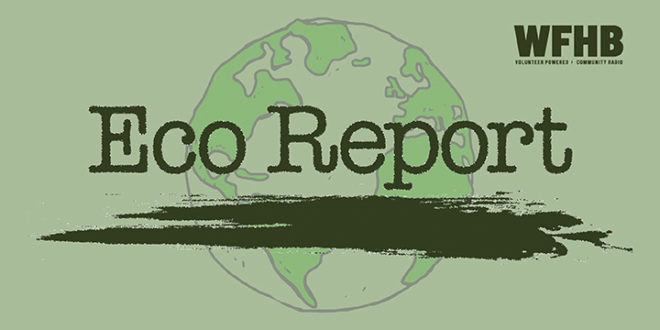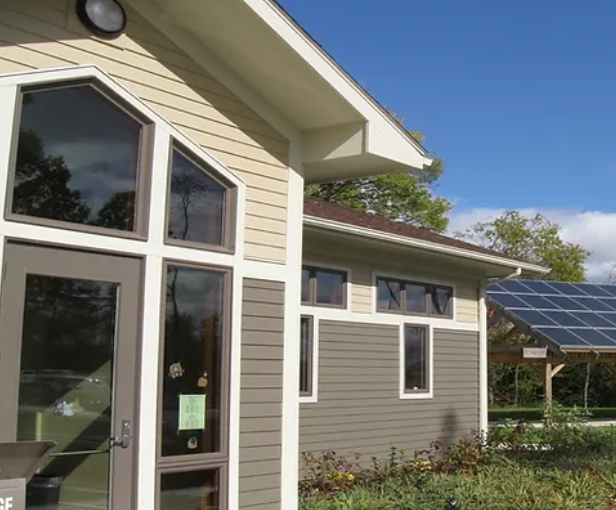Podcast: Play in new window | Download (Duration: 29:40 — 27.2MB)
Subscribe: RSS
Hello and welcome to Eco-Report. For W-F-H-B, I’m Cynthia Roberts and I’m Frank Marshalek.
Later in the program, Environmental Correspondent Zyro Roze speaks with Bill Brown in the second part of an interview with the eco architect. In today’s segment, they discuss the cost benefit analysis of solar energy, adressing the price compared to fossil fuels, financial incentives available, as well as state and federal government policies relating to electrification and the transition to renewable energy.
IndyStar reports on an important development regarding coal ash. The state is allowing AES Indiana to dump more than one million gallons of water contaminated with harmful coal ash pollutants directly into the White River every day, according to Indiana environmental groups who call the approval process a “contradictory shell game.” Indiana regulators recently renewed the utility’s permit for its Eagle Valley plant in Martinsville. The environmental groups claim that the permit violates a federal rule meant to help prevent and clean-up coal ash contamination across the country.
The Hoosier Environmental Council along with the Conservation Law Center is now challenging that permit — arguing that it actually enables the spread of pollution — with the Indiana Office for Environmental Adjudication. “I’m sorry, but pumping contaminated groundwater into the river shouldn’t count as clean-up,” said Indra Frank, the director of environmental health and water policy at HEC. Critics claim the utility is skirting the rules by pumping water contaminated with coal ash from wells installed on the facility to stop the pollution. But then AES Indiana is running that water through the plant’s cooling system before dumping it into the river.
Kim Ferraro with the Conservation Law Center at Indiana University said, “There is a contradictory shell game being played here.” The Indiana Department of Environmental Management, the agency that approved the permit, said the renewal was issued “in accordance with all requirements and provisions of the Clean Water Act” and considered “applicable effluent” limits.
And AES Indiana said it meets all applicable requirements and that it’s “lawfully discharging” under its permit. “AES Indiana, including its Eagle Valley Generating Station, takes pride in its compliance with the environmental regulations and permits,” utility spokeswoman Kelly Young said.
Eagle Valley began operating in 1949 as a coal plant. It produced a lot of coal ash: nearly 3 million cubic yards of the toxic waste. A byproduct from burning coal, the ash contains a dangerous mix of heavy metals and toxic chemicals such as arsenic, boron, lead and mercury. Indiana has the most coal ash ponds of any state in the country, and nearly all of them are leaking into the surrounding waters. This conflict between industry and environment is common in Indiana. Exploitation and profit are the paramount values held by the legislature.
—Norm Holy
IndyStar reports the U.S. Environmental Protection Agency air monitoring near the site of a major fire in Richmond has found multiple toxic substances, including asbestos and hydrogen cyanide, a compound used as a chemical weapon during World War I. The EPA has conducted 24-hour air monitoring and sampling at the site and in neighborhoods surrounding the 175,000-square feet “My Way Trading Warehouse” since the recycled plastics in the building went up in flames April 11. The agency said it found debris containing asbestos in neighborhoods surrounding the warehouse.
The EPA said air monitors detected the presence of hydrogen cyanide, benzene, chlorine, carbon monoxide and volatile organic compounds within the half-mile evacuation zone. The agency sent the collected samples to a laboratory to learn more about the extent of the contamination. The Wayne County Emergency Management Agency has since lifted the evacuation order for residents living within the evacuation zone, but the chemicals detected by the EPA could potentially cause a series of health problems for residents.
Life expectancies in every Indiana county are available for 2018, and it is clear something has been going on in Richmond for years. The life expectancy in Wayne County is 74.3 years, or about 4 years less than the county average in Indiana. A question that we could not answer is whether plastic was burned at the recycling plant prior to the fire. If plastics were burned, there’s the likelihood that the combustion temperatures were too low to destroy toxic materials.
—Norm Holy
A just-published study predicts increasing risk of extremely high temperatures at many places around the earth. Temperatures as high as 120 degrees Fahrenheit are even possible. The study by researchers in Britain identifies which places are most at risk. According to the study, these include economically developed places like Germany, the Netherlands, Belgium and Luxembourg, plus the region of China around Beijing. But they also include developing countries like Afghanistan, Guatemala, Honduras and Papua New Guinea, that are more likely to lack resources to keep people safe. Other areas at particular risk include far eastern Russia, northwestern Argentina and part of northeastern Australia. The study was published last Tuesday in the journal Nature Communications. The Earth has experienced temperatures over 120 degrees during the Jurassic Period, when dinosaurs roamed the Earth. Atmospheric carbon dioxide, from volcanic eruptions, was 2-4 times what we have today.
—Norm Holy
The International Energy Agency reports that carbon capture is very attractive to the fossil fuel industry because it makes possible the continuance of burning of fossil fuels. What is the cost of pairing burning of coal plus carbon capture compared to solar or wind? First, it should be noted that carbon capture applications do not all have the same cost. Looking specifically at carbon capture, the cost can vary greatly by CO2 source, from a range of USD 15-25/times CO2 for industrial processes producing “pure” or highly concentrated CO2 streams (such as ethanol production or natural gas processing) to USD 40-120/times CO2 for processes with “dilute” gas streams, such as cement production and power generation. Capturing CO2 directly from the air is currently the most expensive approach. Some CO2 capture technologies are commercially available now, while others are still in development, and this further contributes to the large range in costs. Carbon capture has been practiced at two power plants, and one of those has been shuttered because of the high cost of carbon capture.
Achieving deep emissions reductions in heavy industry (cement, steel and chemicals production) can be challenging for several reasons. But carbon capture is a relatively advanced and cost-competitive option for dramatically cutting the CO2 emitted during the production of these essential materials. It can also be more cost-effective to retrofit carbon capture to existing facilities than building new capacity with alternative technologies. In the case of cement production, where two-thirds of emissions are from chemical reactions related to heating limestone (rather than burning fossil fuels), carbon capture is currently the only scalable solution for reducing emissions. And in the iron and steel sector, production routes based on carbon capture are currently the most advanced and least-cost low-carbon options.
For power generation, solar and wind are much cheaper than carbon capture.
—Norm Holy
The Coca-Cola Company, PepsiCo, and Nestle came in as the world’s top plastic polluters for five years running, according to Break Free From Plastic’s latest global brand audit report. Since 2018, global cleanups have been carried out by more than 200,000 volunteers in 87 countries to identify the companies with the most plastic waste in the most places. Coca-Cola came in with first place. What is ironic, these findings were revealed as the top polluter at the UN climate change conference COP27 in Egypt where Coca-Cola was serving as a sponsor. Instead of allowing companies like Coke to greenwash their image, governments need to compel polluters to invest in reuse and alternative product delivery systems that avoid the problem in the first place,” said Von Hernandez, Global Coordinator of Break Free From Plastic.
—Julianna Dailey
Hike Trail 5 for an A to Z Lake Hike at Spring Mill State Park on Saturday, May 13th, from 10 to 11 am. As you hike around the lake you will search for all things from A to Z. It will be amazing what you will find. Meet at the Lakeview Activity Center. Enjoy a Wetland Bird Walk with Wild Birds Unlimited on Wednesday, May 17th, from 7:30 to 9 am at the Bean Blossom Bottoms Nature Preserve. Join Ken Keffa and Heather Ray from Wild Birds Unlimited in Bloomington for a guided nature walk through the wetlands. RSVP to Sycamorelandtrust.org/events. A Birdwatching for Beginners class is being offered at Leonard Springs Nature Park on Saturday, May 20th, from 7:30 to 9:30 am. The hike will include several stops where you will look for birds. Binoculars and field guides will be available. Sign up at bloomington.IN.gov/parks.
The Indiana Nature Conservancy is offering a Wildflower Walk at the Hitz-Rhodehamel Nature Preserve in Brown County on Saturday, May 20th, from 10 am to Noon. You can celebrate Endangered Species Day while enjoying the hills and ravines and be on the lookout for oak regeneration, wildflowers and songbirds. A Kids To Park Day is taking place at the Fairfax State Recreation Area at Monroe Lake on Saturday, May 20th, beginning at 4 pm. The day includes an Osprey Watch while the children learn all about Oprey’s. They will practice with binoculars and hike along the lake shore to view an osprey nesting platform. This event is for children ages 6 to 12. Sign up at bit.ly/k2p-2023-osprey.
And that wraps up our show for this week. EcoReport is brought to you in part by M-P-I Solar, a Bloomington business specializing in solar hot water, solar electricity and solar hot air systems. M-P-I Solar designs and installs solar power generation systems that encourage independence and individual responsibility. Found locally at 812-334-4003 and on the Web at M-P-I solar energy dot com.
This week’s headlines were written by Norm Holy and Julianna Dailey.
Today’s news feature was produced by Zyro Roze and edited by Noelle Herhusky-Schneider.
Julianna Dailey assembled the script and was edited by Zyro Roze.
Julianna Dailey compiled our events calendar.
Kade Young, Noelle Herhusky-Schneider and Branden Blewett produced and engineered today’s show.
 WFHB Bloomington Community Radio
WFHB Bloomington Community Radio




